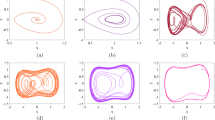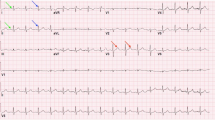Abstract
It is difficult to determine the threshold of mode cell in the interval-thresholding algorithm, when it is used to denoise chaotic signals. In this paper, an adaptive denoising algorithm is proposed for chaotic signals based on improved empirical mode decomposition. First, the noisy chaotic signal is decomposed into the intrinsic mode functions (IMFs) by improved complete ensemble empirical mode decomposition. Then, the zero-crossing scale thresholding denoising algorithm is used to denoise the IMFs with different thresholds. The optimal threshold is obtained by the Durbin–Watson criterion. With the optimal threshold, the final denoised chaotic signal is obtained. The proposed algorithm effectively solves the issue mentioned above. The experimental results show the proposed algorithm can denoise noisy chaotic signals in different conditions effectively and is better than other existing algorithms.








Similar content being viewed by others
References
C. Bandt, B. Pompe, Permutation entropy: a natural complexity measure for time series. Phys. Rev. Lett. 88(17), 174102 (2002)
A.O. Boudraa, J.C. Cexus, EMD-Based Signal Filtering. IEEE Trans. Instrum. Meas. 56(6), 2196–2202 (2007)
G. Chen, T. Ueta, Yet another chaotic attractor. Int. J. Bifurcat. Chaos. 9(7), 1465–1466 (1999)
K. Chen, X.C. Zhou, J.Q. Fang, P.F. Zheng, J. Wang, Fault feature extraction and diagnosis of gearbox based on EEMD and deep briefs network. Int. J. Rotat. Mach. 2017, 9602650 (2017)
Y. Chen, C.T. Wu, H.L. Liu, EMD self-adaptive selecting relevant modes algorithm for FBG spectrum signal. Opt. Fiber Technol. 36, 63–67 (2017)
M.A. Colominas, G. Schlotthauer, M.E. Torres, Improved complete ensemble EMD: a suitable tool for biomedical signal processing. Biomed. Signal Process. Control 14, 19–29 (2014)
D.L. Donoho, De-noising via soft thresholding. IEEE Trans. Inf. Theory 41(3), 613–627 (1995)
Y.N. Guo, S.H. Huang, Y.T. Li, G.R. Naik, Edge effect elimination in single-mixture blind source separation. Circ. Syst. Signal Process. 32(5), 2317–2334 (2013)
Y.N. Guo, Q.J. Liu, A.H. Wang, C.L. Sun, W.Y. Tian, G.R. Naik, A. Abraham, Optimized phase-space reconstruction for accurate musical-instrument signal classification. Multimed. Tools Appl. 76(20), 20719–20737 (2017)
Y.N. Guo, G.R. Naik, S. Huang, A. Abraham, H.T. Nguyen, Nonlinear multiscale maximal Lyapunov exponent for accurate myoelectric signal classification. Appl. Soft Comput. 36, 633–640 (2015)
Y.N. Guo, G.R. Naik, H. Nguyen, Single channel blind source separation based local mean decomposition for Biomedical applications, in The 35th Annual International Conference of the IEEE Engineering in Medicine and Biology Society Osaka, Japan Jul 03–07, pp. 6812–6815 (2013)
M. Han, Y.H. Liu, J.H. Xi, G. Wei, Noise smoothing for nonlinear time series using wavelet soft threshold. IEEE Signal Process. Lett. 14(1), 62–65 (2007)
H. Hao, H.L. Wang, N.U. Rehman, A joint framework for multivariate signal denoising using multivariate empirical mode decomposition. Signal Process. 135, 263–273 (2017)
N.E. Huang, Z. Shen, S.R. Long, M.C. Wu, H.H. Shin, Q. Zheng, N.C. Yen, C.C. Tung, H.H. Liu, The empirical mode decomposition method and the Hilbert spectrum for non-stationary time series analysis. Proc. Roy. Soc. London A. 454, 903–995 (1998)
Y. Kopsinis, S. Mclaughlin, Development of EMD-based denoising methods inspired by wavelet thresholding. IEEE Trans. Signal Process. 57(4), 1351–1362 (2009)
G. Li, B. Zhang, A novel weak signal detection method via chaotic synchronization using Chua’s circuit. IEEE Trans. Ind. Electron. 64(3), 2255–2265 (2017)
Y. Ma, W.B. Shi, C.K. Peng, A.C. Yang, Nonlinear dynamical analysis of sleep electroencephalography using fractal and entropy approaches. Sleep Med. Rev. 37, 85–93 (2018)
G.R. Naik, S.E. Selvan, H.T. Nguyen, Single-channel EMG classification with ensemble-empirical-mode-decomposition-based ICA for diagnosing neuromuscular disorders. IEEE Trans. Neur. Sys. Reh. 24(7), 734–743 (2016)
D.N. Rutledge, A.S. Barros, Durbin–Watson statistic as a morphological estimator of information content. Anal. Chim. Acta 454(2), 277–295 (2002)
R.W. Schafer, What Is a Savitzky–Golay filter? IEEE Signal Process. Mag. 28(4), 111–117 (2011)
J.S. Smith, The local mean decomposition and its application to EEG perception data. J. R. Soc. Interface 2(5), 443–454 (2005)
J.W. Sun, Y. Shen, Q. Yin, C.J. Xu, Compound synchronization of four memristor chaotic oscillator systems and secure communication. Chaos. 23(1), 013140 (2013)
M.E. Torres, M.A. Colominas, G. Schlotthauer, P. Flandrin, A complete ensemble empirical mode decomposition with adaptive noise, in The 36th IEEE International Conference on Acoustics, Speech, and Signal Processing, (ICASSP 2011) May 2011, pp. 4144–4147
K. Urbanowicz, J.A. Hołyst, Noise-level estimation of time series using coarse-grained entropy. Phys. Rev. E 67(4), 046218 (2003)
G. Vivó-Truyols, P.J. Schoenmakers, Automatic selection of optimal Savitzky–Golay smoothing. Anal. Chem. 78(13), 4598–4608 (2006)
M.J. Wang, Y.C. Zeng, C.Q. Xie, G.F. Zhu, S.H. Tang, Application of Chen’s system to detecting weak harmonic signals. Acta Phys. Sin. 61(18), 180502 (2012)
X.Y. Wang, X.M. Bao, A novel image block cryptosystem based on a spatiotemporal chaotic system and a chaotic neural network. Chin. Phys. B 22(5), 050508 (2013)
Z. Wu, N.E. Huang, Ensemble empirical mode decomposition: a noise-assisted data analysis method. Adv. Adapt. Data Anal. 1(1), 1–41 (2009)
Acknowledgements
This work is supported by the National Natural Science Foundation of China (Grant Nos. 61471310, 11747087), the Research Foundation of Education Bureau of Hunan Province, China (Grant No. 17C1530), and the Natural Science Foundation of Xiangtan University, China (Grant No. 15XZX33).
Author information
Authors and Affiliations
Corresponding author
Rights and permissions
About this article
Cite this article
Wang, M., Zhou, Z., Li, Z. et al. An Adaptive Denoising Algorithm for Chaotic Signals Based on Improved Empirical Mode Decomposition. Circuits Syst Signal Process 38, 2471–2488 (2019). https://doi.org/10.1007/s00034-018-0973-7
Received:
Revised:
Accepted:
Published:
Issue Date:
DOI: https://doi.org/10.1007/s00034-018-0973-7




